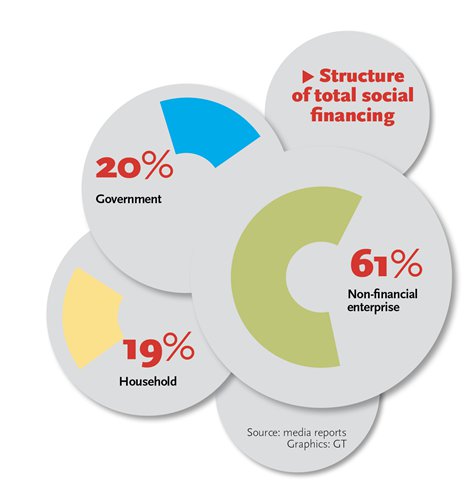
Structure of total social financing
Experts expect more steps to support real economy
Much of the total social financing (TSF) in China last year flowed into the coffers of local governments, households and the property sector, according to a recent report jointly released by a government-backed think tank - the National Institution for Finance & Development (NIFD) - and China Zheshang Bank Co.
TSF, the broadest measure of credit in China, reached 182 trillion yuan ($26.9 trillion), and about 20 percent went to governments at various levels, domestic news site ifeng.com reported on Wednesday, citing the report.
Of that portion, money going to the central government accounted for 7 percent, down 4 percentage points from 2009, while the money going to regional governments surged to 14 percent.
Meanwhile, nearly 111 trillion yuan flowed to nonfinancial corporations, which accounted for 61 percent of the total. The report also noted that China's financing channels have become more diversified in recent years; meanwhile, more and more money has gone into real estate in several forms such as property-related corporate loans, mortgages and related infrastructure projects.
"For now, the property projects are considered as investment with an added value, which involve living standards and the country's economic growth. That explains why most of the money flowed into real estate," Song Qinghui, an independent economist, told the Global Times on Wednesday.
Many households in China have been turning their family wealth into real estate by buying two or more homes, some of which are investments, Dong Dengxin, director of the Finance and Securities Institute at Wuhan University of Science and Technology, told the Global Times.
"This phenomenon has driven the rapid growth of China's property market, which absorbs more and more capital of many households as well as property developers," he said.
The report estimated that nonbanking financial institutions provided 25 trillion yuan of the total, of which 30 percent went into infrastructure and real estate projects.
Another significant driver of money flows is booming equity investment, Dong noted. "Rising merger and acquisition (M&A) activities absorbed a significant amount of money too, and became a major speculative force."
China's M&A deal volumes had another record year in 2016, with an increase of 21 percent to 11,409, according to a report released by PwC in January 2017.
Total deal values grew 11 percent year-on-year to $770 billion. Within that, 21 percent of the increase in overall deal volume was driven by the growth in financial-buyer activity, which was a new record, the report showed.
In the second half, regulators are expected to come up with more measures to stabilize the financial market and more money has to be rechanneled to support the real economy, according to a meeting of the Political Bureau of the Central Committee of the Communist Party of China on Monday.
"Authorities will crack down more on speculative activities in the M&A sector, which are accompanied by highly leveraged financing," Dong said, noting that direct debt and equity financing will lower risks.
To tackle the chaos in the financial sector, regulators will initially focus on curbing shadow banks, Li Yang, director-general of the NIFD, was quoted as saying in the media report on Wednesday. The People's Bank of China, the central bank, has been introducing policies to restrain the shadow banking sector since the second half of 2016.
For instance, under its Macro Prudential Assessment framework and changes in the monetary policy stance to moderately neutral from moderate, the economic incentives behind several key shadow banking practices have been reduced, Moody's said in a report sent to the Global Times.
Still, channeling funds to sectors other rather than real estate will be a long-term task, Huang Jianzhong, a finance professor at Shanghai Normal University, told the Global Times on Wednesday. "It's about the economic revival, the continuous improvement of the business environment and upcoming policies to relieve companies' burden," he said.


















































